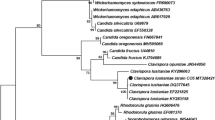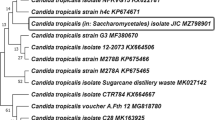Abstract
Manganese (Mn) is an essential heavy metal for living organisms. However, they tend to accumulate the excess of this element causing health problems. The increase of the environmental contamination by this heavy metal is mainly due to mining practices. This work aimed to isolate yeast from mining waters to evaluate its ability of removing Mn2+ ions for the development of further biotechnological and bioremediation applications. The growing interest of this study is because it could be effective in the biological treatment of contaminated water, which remains a major challenge for industry and environment. Yeasts were initially isolated from mining water and grown in YPD medium containing 1 to 54 mM Mn2+. Subsequently, the isolates were characterized biochemically and phylogenetically. Then, we evaluate the ability of the isolates of removing Mn2+ ion by SEM scanning electron microscopy coupled with SEM/EDX. Our results showed yeast growth up to 32 mM. There was no pH increase along the tests, suggesting a biological Mn2+ removal. Taken together, the morphological changes in the colony and the darkening of the culture medium suggest the yeast’s ability of oxidizing Mn2+. Five isolates remove these ions considerably, identified as Rhodotorula mucilaginosa. SEM/EDX analysis shows the ability to oxidize and adsorb Mn. The data obtained in this work allows us to conclude that R. mucilaginosa has an important role in the biogeochemical cycle of manganese and present potential biotechnological applications for bioremediation of water contaminated with Mn2+ ions.







Similar content being viewed by others
Abbreviations
- EDS:
-
Microanalysis by energy dispersive spectrometry
- EDX:
-
Energy dispersive spectroscopy
- ICP-OES:
-
Plasma atomic emission spectrometry
- ITS:
-
Internal transcribed spacer
- PDA:
-
Potato agar dextrose
- SEM:
-
Scanning electron microscopy
- YDP:
-
Peptone yeast extract dextrose
References
Amorim, S. S., Ruas, F. A. D., Barboza, N. R., Oliveira, V. G. N., Leão, V. A., & Guerra-Sá, R. (2018). Manganese (Mn2+) tolerance and biosorption by Meyerozyma guilliermondii and Meyerozyma caribbica strains. Journal of Environmental Chemical Engineering, 6(4), 4538–4545. https://doi.org/10.1016/j.jece.2018.06.061.
Azubuike, C. C., Chikere, B. C., & Okpokwasili, G. C. (2016). Bioremediation techniques-classification based on site of application: Principles, advantages, limitations and prospects. World Journal of Microbiology and Biotechnology, 32, 1–18. https://doi.org/10.1007/s11274-016-2137-x.
Bahafid, W., Joutey, N. T., Asri, M., Sayel, H., Tirry, N., & Ghachtouli, N. El. (2017). Yeast biomass: An alternative for bioremediation of heavy metals. In Yeast - Industrial Applications (pp. 269–289). https://doi.org/10.5772/intechopen.70559.
Carolin, C. F., Kumar, P. S., Saravanan, A., Joshiba, G. J., & Naushad, M. (2017). Efficient techniques for the removal of toxic heavy metals from aquatic environment: A review. Journal of Environmental Chemical Engineering, 5(3), 2782–2799. https://doi.org/10.1016/j.jece.2017.05.029.
Conselho Nacional do Meio Ambiente-CONAMA. (2005). Resolução No 357, De 17 de março de 2005 - CONAMA. http://pnqa.ana.gov.br/Publicacao/RESOLUCAO_CONAMA_n_357.pdf. Accessed 29 January 2019.
Conselho Nacional do Meio Ambiente-CONAMA. (2011). Resolução N° 430, de 13 de maio de 2011- CONAMA. https://www.mprs.mp.br/media/areas/gapp/arquivos/atualizacao_intra/dou/res_conama_430.pdf. Accessed 29 January 2019.
Dangi, A. K., Sharma, B., Hill, R. T., & Shukla, P. (2018). Bioremediation through microbes: Systems biology and metabolic engineering approach. Critical Reviews in Biotechnology, 39(1), 1–20. https://doi.org/10.1080/07388551.2018.1500997.
Das, N., Vimala, R., & Karthika, P. (2008). Biosorption of heavy metals - An overview. Indian Journal of Biotechnology, 7(2), 159–169. https://doi.org/10.1016/j.is.2009.02.003.
Das, A. P., Sukla, L. B., Pradhan, N., & Nayak, S. (2011). Manganese biomining: A review. Bioresource Technology, 102, 7381–7387. https://doi.org/10.1016/j.biortech.2011.05.018.
Dixit, R., Wasiullah, Malaviya, D., Pandiyan, K., Singh, U. B., Sahu, A., et al. (2015). Bioremediation of heavy metals from soil and aquatic environment: An overview of principles and criteria of fundamental processes. Sustainability (Switzerland), 7(2), 2189–2212. https://doi.org/10.3390/su7022189.
Erikson, K. M., Syversen, T., Aschner, J. L., & Aschner, M. (2005). Interactions between excessive manganese exposures and dietary iron-deficiency in neurodegeneration. Environmental Toxicology and Pharmacology, 19, 415–421. https://doi.org/10.1016/j.etap.2004.12.053.
Fadel, M., Hassanein, N. M., Elshafei, M. M., Mostafa, A. H., Ahmed, M. A., & Khater, H. M. (2017). Biosorption of manganese from groundwater by biomass of Saccharomyces cerevisiae. HBRC Journal, 13(1), 106–113. https://doi.org/10.1016/j.hbrcj.2014.12.006.
Fell, J. W., Boekhout, T., Fonseca, A., Scorzetti, G., & Statzell-Tallman, A. (2000). Biodiversity and systematics of basidiomycetous yeasts as determined by large-subunit rDNA D1/D2 domain sequence analysis. International Journal of Systematic and Evolutionary Microbiology (Vol. 50). www.microbiologyresearch.org. Accessed 25 January 2019.
Gadd, G. M. (2007). Geomycology : biogeochemical transformations of rocks , minerals , metals and radionuclides by fungi , bioweathering and bioremediation. Mycological Research, 111, 3–49. https://doi.org/10.1016/j.mycres.2006.12.001.
Gardes, M., & Bruns, T. D. (1993). ITS primers with enhanced specificity for basidiomycetes - application to the identification of mycorrhizae and rusts. Molecular Ecology, 2(2), 113–118. https://doi.org/10.1111/j.1365-294X.1993.tb00005.x.
Geszvain, K., Butterfield, C., Davis, R. E., Madison, A. S., Lee, S.-W., Parker, D. L., et al. (2012). The molecular biogeochemistry of manganese (II) oxidation. Biochemical Society Transactions, 40(6), 1244–1248. https://doi.org/10.1042/BST20120229.
Goldstein, J. I., Newbury, D. E., Echlin, P., Joy, D. C., Romig, A. D., Lyman, C. E., et al. (1992). Scanning electron microscopy and X-ray microanalysis. A text for biologists, and geologist. In Scanning electron microscopy and X-ray microanalysis (pp. 1–19). Boston, MA: Springer US. https://doi.org/10.1007/978-1-4613-0491-3_1.
Gomes, N. C. M., Rosa, C. A., Pimentel, P. F., & Mendonca-Hagler, L. C. S. (2002). Uptake of free and complexed silver ions by different strains of Rhodotorula mucilaginosa. Brazilian Journal Microbiology, 33, 62–66. https://doi.org/10.1590/S1517-83822002000100013.
Haack, E. A., & Warren, L. A. (2003). Biofilm hydrous manganese oxyhydroxides and metal dynamics in acid rock drainage. Environmental Science & Technology, 37(18), 4138–4147. https://doi.org/10.1021/es026274z.
Ibrahim, S., El-Liethy, M. A., Elwakeel, K. Z., Hasan, M. A. E. G., Al Zanaty, A. M., & Kamel, M. M. (2020). Role of identified bacterial consortium in treatment of Quhafa wastewater treatment plant influent in Fayuom, Egypt. Environmental Monitoring and Assessment, 192(3). https://doi.org/10.1007/s10661-020-8105-9.
Jarboui, R., Baati, H., Fetoui, F., Gargouri, A., Gharsallah, N., & Ammar, E. (2012). Yeast performance in wastewater treatment: Case study of Rhodotorula mucilaginosa. Environmental Technology, 33(8), 951–960. https://doi.org/10.1080/09593330.2011.603753.
Jung, K. W., Lee, S. Y., Choi, J. W., & Lee, Y. J. (2019). A facile one-pot hydrothermal synthesis of hydroxyapatite/biochar nanocomposites: Adsorption behavior and mechanisms for the removal of copper(II) from aqueous media. Chemical Engineering Journal, 369, 529–541. https://doi.org/10.1016/j.cej.2019.03.102.
Kafaei, R., Tahmasbi, R., Ravanipour, M., Dariush, Vakilabadi, R., Ahmadi, M., et al. (2017). Urinary arsenic, cadmium, manganese, nickel, and vanadium levels of schoolchildren in the vicinity of the industrialised area of Asaluyeh, Iran. Environmental Science and Pollution Research, 24, 23498–23507. https://doi.org/10.1007/s11356-017-9981-6.
Khan, A., Muhammad Yousafzai, A., Latif, M., Ur Rehman, A., Khan, Q., Zaib, A., et al. (2014). Analysis of selected water quality parameters and heavy metals of Indus River at Beka Swabi, Khyber Pakhtunkhwa, Pakistan. International Journal of Biosciences, 4(2), 28–38. https://doi.org/10.12692/ijb/4.2.28-38.
Kohl, P. P. M., & Medlar, S. J. S. (2006). Occurrence of manganese in drinking water and manganese control. American Water Works Association. Awwa Research Foundation. https://books.google.com.br/books?hl=pt-BR&lr=&id=CU-I4UO1xXsC&oi=fnd&pg=PR9&dq=Medlar,+2006&ots=Pt1-nIL6Ir&sig=BwzO8HvmGHp-pLpQEN58DF0wSII#v=onepage&q=Medlar%2C2006&f=false. Accessed 1 February 2018.
Konovalov, S. K., Luther, G. W., Friederich, G. E., Nuzzio, D. B., Tebo, B. M., Murray, J. W., et al. (2003). Lateral injection of oxygen with the Bosporus plume-fingers of oxidizing potential in the Black Sea. Limnology and Oceanography, 48. https://doi.org/10.4319/lo.2003.48.6.2369.
Kornblith, E., Casey, S. L., & Bowler, R. M. (2019). Environmental exposure to manganese in air: Tremor, motor and cognitive symptom profiles. Neurotoxicology, 64, 152–158. https://doi.org/10.1016/j.neuro.2017.09.012.Environmental.
Krystofova, O., Shestivska, V., Galiova, M., Novotny, K., Kaiser, J., Zehnalek, J., et al. (2009). Sunflower plants as bioindicators of environmental pollution with lead (II) ions. Sensors, 9, 5040–5058. https://doi.org/10.3390/s90705040.
Kurtzman, C. P., Fell, J. W., & Boekhout, T. (2011). The yeasts, a taxonomic study. (Elsevier, Ed.) (fifth.). Elsevier Science.
Lovley, D. R. (1991). Dissimilatory Fe(III) and Mn(IV) reduction. Microbiological Reviews, 55(2), 259–287 0146-0749/91/020259-29$02.00/0.
Madu, P. C., Akpaiyo, G. D., & Ikoku, P. (2011). Biosorption of Cr3+ , Pb2+ , and Cd2+ ions from aqueous solution using modified and unmodified millet chaff. J. Chem. Pharm. Res, pp. 467–477. http://www.jocpr.com/articles/biosorption-of-cr3-pb2-and-cd2-ions-from-aqueous-solution-using-modified-and-unmodified-millet-chaff.pdf. Accessed 31 January 2019.
Mohapatra, R. K., Parhi, P. K., Pandey, S., Bindhani, B. K., Thatoi, H., & Panda, C. R. (2019). Active and passive biosorption of Pb(II) using live and dead biomass of marine bacterium Bacillus xiamenensis PbRPSD202: Kinetics and isotherm studies. Journal of Environmental Management, 247, 121–134. https://doi.org/10.1016/j.jenvman.2019.06.073.
Nealson, K. H. (2006). The manganese-oxidizing bacteria. In The prokaryotes (pp. 222–231). New York, NY: Springer New York. https://doi.org/10.1007/0-387-30745-1_11.
Olasupo, N. A., Scottemuakpor, M. B., & Ogunshola, R. A. (1993). Resistance to heavy-metals by some Nigerian yeast strains. Folia Microbiologica, 38(4), 285–287. https://doi.org/10.1007/BF02898595.
Patil, D. S., Chavan, S. M., & Oubagaranadin, J. U. K. (2016). A review of technologies for manganese removal from wastewaters. Journal of Environmental Chemical Engineering, 4(1), 468–487. https://doi.org/10.1016/j.jece.2015.11.028.
Piazza, A., Casalini, L. C., Pacini, V. A., Sanguinetti, G., Ottado, J., & Gottig, N. (2019). Environmental bacteria involved in manganese (II) oxidation and removal from groundwater. Frontiers in Microbiology, 10(FEB), 1–13. https://doi.org/10.3389/fmicb.2019.00119.
Pieper, D. H., & Reineke, W. (2000). Engineering bacteria for bioremediation of persistent organochlorine. Current Opinion in Biotechnology, 11, 262–270. https://doi.org/10.1016/j.biortech.2013.09.084.
Rajpert, L., Skłodowska, A., & Matlakowska, R. (2013). Biotransformation of copper from Kupferschiefer black shale (fore-Sudetic monocline, Poland) by yeast Rhodotorula mucilaginosa LM9. https://doi.org/10.1016/j.chemosphere.2013.02.022.
Roşca, M., Hlihor, R. M., Cozma, P., Drăgoi, E. N., Diaconu, M., Silva, B., et al. (2018). Comparison of Rhodotorula sp. and Bacillus megaterium in the removal of cadmium ions from liquid effluents. Green Process Synth, 7, 74–88. https://doi.org/10.1515/gps-2016-0218.
Rumsby, P., Rockett, L., Clegg, H., Jonsson, J., Benson, V., Harman, M., et al. (2014). Speciation of manganese in drinking water. Toxicology Letters, 229(March), S120. https://doi.org/10.1016/j.toxlet.2014.06.431.
Salvadori, M. R., Ando, R. A., Nascimento, C. A., & Corrêa, B. (2014). Intracellular biosynthesis and removal of copper nanoparticles by dead biomass of yeast isolated from the wastewater of a mine in the Brazilian Amazonia. Plos One, 9, e87968. https://doi.org/10.1371/journal.pone.0087968.
Sanger, F., & Coulson, A. R. (1975). A rapid method for determining sequences in DNA by primed synthesis with DNA polymerase. Journal of Molecular Biology, 94, 441–446. https://doi.org/10.1016/0022-2836(75)90213-2.
Singh, P., Singh, S. M., Tsuji, M., Prasad, G. S., & Hoshino, T. (2014). Rhodotorula svalbardensis sp. nov., a novel yeast species isolated from cryoconite holes of Ny-Ålesund, Arctic. Cryobiology, 68(1), 122–128. https://doi.org/10.1016/j.cryobiol.2014.01.006.
Takano, Y., Takayanagi, N., Hori, H., Ikeuchi, Y., Suzuki, T., Kimura, A., & Okuno, T. (2006). A gene involved in modifying transfer RNA is required for fungal pathogenicity and stress tolerance of Colletotrichum lagenarium. Molecular Microbiology, 60(1), 81–92. https://doi.org/10.1111/j.1365-2958.2006.05080.x.
Tebo, B. M., Bargar, J. R., Clement, B. G., Dick, G. J., Murray, K. J., Parker, D., et al. (2004). Biogenic manganese oxides: Properties and mechanisms of formation. Annual Review of Earth and Planetary Sciences, 32(1), 287–328. https://doi.org/10.1146/annurev.earth.32.101802.120213.
Webb, S. M., Dick, G. J., Bargar, J. R., & Tebo, B. M. (2005). Evidence for the presence of Mn (III) intermediates in the bacterial oxidation of Mn (II). Proceedings of the National Academy of Sciences, 102(15), 5558–5563. https://doi.org/10.1073/pnas.0409119102.
Yabuki, T., Motoda, Y., Hanada, K., Nunokawa, E., Saito, M., Seki, E., et al. (2007). A robust two-step PCR method of template DNA production for high-throughput cell-free protein synthesis. Journal of Structural and Functional Genomics, 8(4), 173–191. https://doi.org/10.1007/s10969-007-9038-z.
Zhao, Y., Zhu, G., & Cheng, Z. (2010). Thermal analysis and kinetic modeling of manganese oxide ore reduction using biomass straw as reductant. Hydrometallurgy, 105, 96–102. https://doi.org/10.1016/j.hydromet.2010.08.004.
Funding
This study was sponsored by the Conselho Nacional de Pesquisa e Desenvolvimento (CNPq) [310733/2014-6], Fundação de Amparo à Pesquisa do Estado de Minas Gerais (FAPEMIG), Financiadora de Estudos e Projetos (FINEP), CAPES (Coordenação de Aperfeiçoamento de Pessoal de Nível Superior), Vale, and Universidade Federal de Ouro Preto (UFOP).
Author information
Authors and Affiliations
Corresponding author
Ethics declarations
Conflict of Interest
The authors declare no conflict of interest.
Additional information
Publisher’s Note
Springer Nature remains neutral with regard to jurisdictional claims in published maps and institutional affiliations.
Electronic supplementary material
ESM 1
(DOCX 345 kb)
Rights and permissions
About this article
Cite this article
Ruas, F.A.D., Amorim, S.S., Leão, V.A. et al. Rhodotorula mucilaginosa Isolated from the Manganese Mine Water in Minas Gerais, Brazil: Potential Employment for Bioremediation of Contaminated Water. Water Air Soil Pollut 231, 527 (2020). https://doi.org/10.1007/s11270-020-04896-1
Received:
Accepted:
Published:
DOI: https://doi.org/10.1007/s11270-020-04896-1




